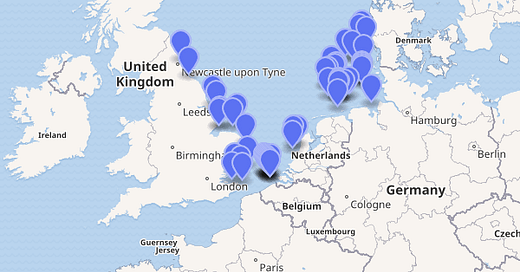Chapter 12
Why Can’t the United States Get its Act Together on Offshore Wind?
Offshore wind farms are popping up all over the world. The North Sea is ringed with operational turbines off Scotland, England, Germany, Denmark, the Netherlands and Belgium. The same is true off some parts of Asia.
But the U.S. can’t seem to get its act together. Rich homeowners like RFK jr. were able to kill Cape Wind because its turbines would loom up only a few inches above their view of the horizon. The project would have replaced power to hundreds of thousand homes that lost their primary source of energy when the Pilgrim Nuclear Power Plant was shuttered.
Fossil fuel lobbyists have been able to astroturf, setting up fake green environmental organizations, that present false information about the effects of wind turbines on whales and fish. Whales are far more damaged by collisions with ships and entanglements with fishing gear than they are by the slight vibrations from wind turbines.
Fish will be helped by wind farms because the farms will provide fish with reserves free of fishing boats where the fish can breed and feed safe from fishing pressure.
A few years after such reserves are created around such offshore structures you can see fishing boats clustered outside the reserves fishing for the abundance of large overflow fish just outside the reserve.
But the other shoe fell on September 25, 2024, when New Jersey granted Leading Light Wind a pause on its offshore wind project so its developers could find wind turbines in the wake of GE Verona’s problems with its broken blades. It was a tacit admittance that the problem ran much deeper than just three broken blades off Nantucket and England’s Dogger Banks. The entire industry was paying for Verona’s making its blades too big and too fast.
The developers had planned to build a hundred wind turbines 40 miles off the jersey Shore but now there were only two companies, Vestas of Denmark and Siemens of Germany, able to make offshore wind blades.
But the developers deemed Vesta’s blades unsuitable and Siemens had announced in June that it was substantially raising the price of its turbines. Leaving the developers without a turbine supplier.
The president of the New jersey ‘s utilities board tried to put a positive spin on the situation saying the delay would help move the project forward.
It was just the latest setback for the industry that had been advancing by fits and starts up and down the U.S. East Coast. New Jersey had been particularly hard hit. The Danish company Orstaed had scrapped two offshore projects that it deemed no longer financially feasible and Atlantic Shores was seeking to rebid the financial terms of its project.
Despite all the challenges, installing offshore wind farms in the single most important thing the East Coast can do to both insure its supply of future energy and offset global warming. It just has to be done cautiously and thoroughly aided by incentives from the federal government.
It would be seen whether that crucial component would continue after the outcome of the Presidential election fast approaching in November.




